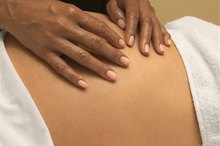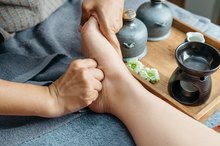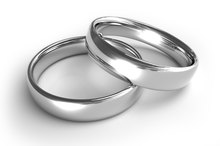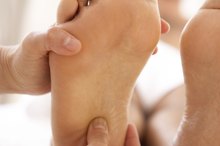About Pressure Points for a Foot Massage
Applying pressure to specific points on the foot is a healing practice that's been used for thousands of years. In addition to offering the relaxing benefits of massage, stimulating points on the feet can also stimulate other parts of the body to help relieve discomfort associated with conditions such as diabetes, asthma, anxiety or headaches. Although navigating your way through all the pressure points is best done with a map -- a tool created by reflexologists and acupressure practitioners -- having a basic understanding of the practice can get your pressure point massage off on the right foot.
If you are experiencing serious medical symptoms, seek emergency treatment immediately.
History of Pressure Point Therapy
Pressure point therapies such as acupuncture, acupressure and reflexology, have roots that are believe to extend for thousands of years. The practices are often associated with Asian healing practices, although there are pictographs suggesting Egyptians practiced foot massage as far back as 2500 B.C. In Western medicine, using touch as means for healing can be traced back to the 5th century B.C., with Hippocrates' teachings on the power of massage for healing and aiding tissue growth. In the 1930's, physiotherapist Eunice Ingham developed maps of the pressure points in the feet after finding that the foot is one of the most responsive body parts to pressure point therapy.
- Pressure point therapies such as acupuncture, acupressure and reflexology, have roots that are believe to extend for thousands of years.
- The practices are often associated with Asian healing practices, although there are pictographs suggesting Egyptians practiced foot massage as far back as 2500 B.C.
- In Western medicine, using touch as means for healing can be traced back to the 5th century B.C., with Hippocrates' teachings on the power of massage for healing and aiding tissue growth.
Pressure Points: A Working Definition
Differences Between Shiatsu & Swedish Massage
Learn More
Pressure points on the foot are believed to correspond to different organs, bones and systems in the body. In reflexology or acupressure, these points are massaged to stimulate the corresponding body part 5. The practice isn't used as a curative treatment; instead, pressure point therapies are used as complementary therapies to support overall health and alleviate discomfort associated with certain conditions. Although there isn't a wealth of scientific research, practitioners believe that stimulating these pressure points has far more health benefits and positive effects than a simple foot massage, which aims to relax the muscles in the foot.
- Pressure points on the foot are believed to correspond to different organs, bones and systems in the body.
- Although there isn't a wealth of scientific research, practitioners believe that stimulating these pressure points has far more health benefits and positive effects than a simple foot massage, which aims to relax the muscles in the foot.
Pressure Points in the Foot
Although identifying pressure points on the foot is complex, at its most basic, each foot corresponds to organs, bones and systems on that side of the body. Different points are located on the inner and outer foot as well as the bottom and top of each foot. Most maps of pressure points break it down further to identify specific parts of the foot that stimulate specific regions of the body and further still to identify specific body parts. For example, everything above the base of the toes corresponds to the shoulder line of the body, including the head, sinuses, jaw, teeth, ears and throat. The tip of the big toe typically corresponds to the brain, while the base of the big toe relates to the neck.
- Although identifying pressure points on the foot is complex, at its most basic, each foot corresponds to organs, bones and systems on that side of the body.
- For example, everything above the base of the toes corresponds to the shoulder line of the body, including the head, sinuses, jaw, teeth, ears and throat.
Techniques for Activating Pressure Points
Differences Between Shiatsu & Swedish Massage
Learn More
Unlike traditional massage techniques, which are typically larger movements such as stroking, kneading or tapping, pressure point massage uses smaller, micromovements to create responses in the body. One of the most basic techniques for activating a pressure point on the foot, is to simply press on the point for 10 seconds, three times in a row. Other basic techniques include gripping the pressure point with the flat of your thumb and finger to put pressure on it and walking your fingers across a specific area, such as the inner or outer foot, while steadily applying pressure.
Related Articles
References
- Healthy Healing; Linda R. Page
- Reflexology for Beginners; David Vennells
- Healing Yourself with Pressure Point Therapy; Jack Foremv
- University of Minnesota: Reflexology
- The Reflexology Bible; Louise Keet
- Brown CA, Lido C. Reflexology treatment for patients with lower limb amputations and phantom limb pain-An exploratory pilot study. Complement Ther Clin Pract. 2008 May;14(2):124-31. Epub 2008 Mar 4.
- Dibble SL, Luce J, Cooper BA, Israel J, Cohen M, Nussey B, Rugo H. Acupressure for chemotherapy-induced nausea and vomiting: a randomized clinical trial. Oncol Nurs Forum. 2007 Jul;34(4):813-20.
- Lee YM. [Effect of self-foot reflexology massage on depression, stress responses and immune functions of middle-aged women]. Taehan Kanho Hakhoe Chi. 2006 Feb;36(1):179-88.
- Li X, Hirokawa M, Inoue Y, Sugano N, Oian S, Iwai T. Effects of acupressure on lower limb blood flow for the treatment of peripheral arterial occlusive diseases. Surg Today. 2007;37(2):103-8. Epub 2007 Jan 25.
- Mars M, Desai Y, Gregory MA. Compressed air massage hastens healing of the diabetic foot. Diabetes Technol Ther. 2008 Feb;10(1):39-45.
- Park HS, Cho GY. [Effects of foot reflexology on essential hypertension patients]. Taehan Kanho Hakhoe Chi. 2004 Aug;34(5):739-50.
- Quattrin R, Zanini A, Buchini S, Turello D, Annunziata MA, Vidotti C, Colombatti A, Brusaferro S. Use of reflexology foot massage to reduce anxiety in hospitalized cancer patients in chemotherapy treatment: methodology and outcomes. J Nurs Manag. 2006 Mar;14(2):96-105.
- Stephenson NL, Swanson M, Dalton J, Keefe FJ, Engelke M. Partner-delivered reflexology: effects on cancer pain and anxiety. Oncol Nurs Forum. 2007 Jan;34(1):127-32.
- Wang HL, Keck JF. Foot and hand massage as an intervention for postoperative pain. Pain Manag Nurs. 2004 Jun;5(2);59-65.
- Williamson J, White A, Hart A, Ernst E. Randomised controlled trial of reflexology for menopausal symptoms. BJOG. 2002 Sep;109(9):1050-5.
- Yang JH. [The effects of foot reflexology on nausea, vomiting, and fatigue of breast cancer patients undergoing chemotherapy]. Taehan Kanho Hakhoe Chi. 2005 Feb;35(1):177-85.
Writer Bio
Kent Ninomiya is a veteran journalist with over 23 years experience as a television news anchor, reporter and managing editor. He traveled to more than 100 countries on all seven continents, including Antarctica. Ninomiya holds a Bachelor of Arts in social sciences with emphasis in history, political science and mass communications from the University of California at Berkeley.








